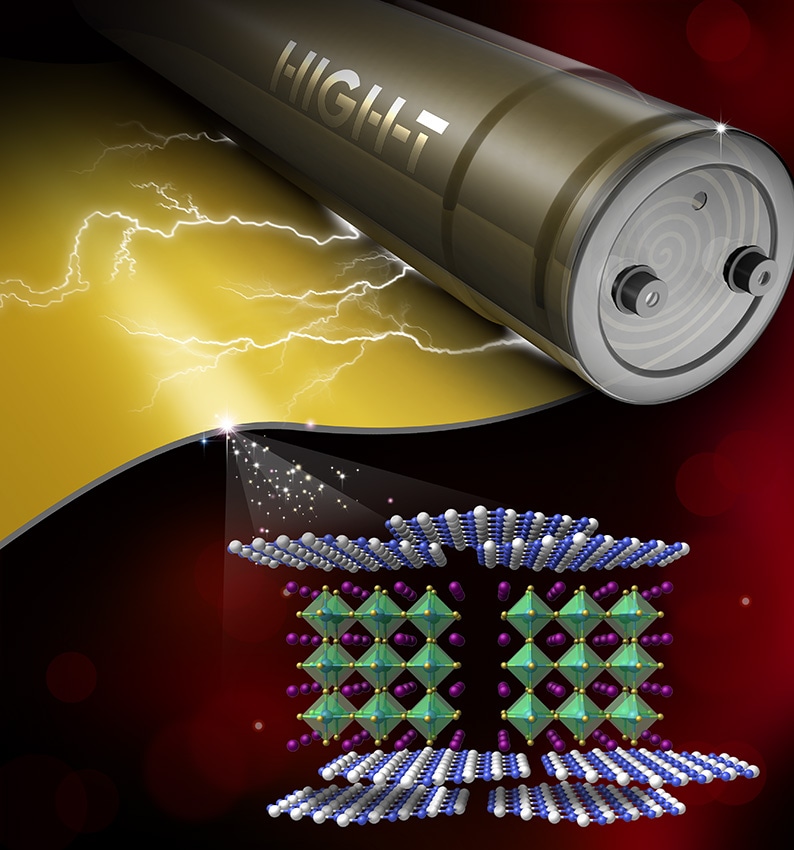Aug 24 2016
 Boron nitride nanosheets (blue and white atoms) act as insulators to protect a barium nitrate central layer (green and purple atoms) for high temperature energy storage. (Credit: Wang Lab/Penn State)
Boron nitride nanosheets (blue and white atoms) act as insulators to protect a barium nitrate central layer (green and purple atoms) for high temperature energy storage. (Credit: Wang Lab/Penn State)
Penn State materials researchers have achieved the energy-storage goal of a polymer dielectric material possessing high power density, high energy density, and superior charge-discharge efficiency for hybrid and electric vehicle applications.
A unique 3D sandwich-like structure is the key that protects the dense electric field in the polymer/ceramic composite from dielectric breakdown. Their research findings have been published in the Proceedings of the National Academy of Sciences (PNAS).
Polymers are ideal for energy storage for transportation due to their light weight, scalability and high dielectric strength. However, the existing commercial polymer used in hybrid and electric vehicles, called BOPP, cannot stand up to the high operating temperatures without considerable additional cooling equipment. This adds to the weight and expense of the vehicles.
Qing Wang, Professor, Penn State
Two problems had to be overcome in order for the researchers to attain their goal. In regular 2D polymer films such as BOPP, raising the dielectric constant, the strength of the electric field, is in conflict with charge-discharge efficiency and stability.
A material is more likely to leak energy in the form of heat when the field is stronger.
The Penn State team first tackled this issue by combining different materials while trying to balance opposing properties in a 2D form. While this boosted the energy capacity, they discovered that the film broke down at high temperatures when electrons broke out of the electrodes and were injected into the polymer, which caused an electric current to develop.
That’s why we developed this sandwich structure. We have the top and bottom layers that block charge injection from the electrodes. Then in the central layer we can put all of the high dielectric constant ceramic/polymer filler material that improves the energy and power density.
Qing Wang, Professor, Penn State
The outer layers, made up of boron nitride nanosheets in a polymer matrix, are exceptional insulators, while the central layer is a high dielectric constant material known as barium titanate.
Comparison to BOPP
A comparison of BOPP and the sandwich structure nanocomposite - SSN-x - reveals that at 150°C, SSN-x has the same charge-discharge energy as BOPP at it regular operating temperature of 70°C. The ‘x’ refers to the percentage of barium titanate nanocomposites existing in the central layer.
However, SSN-x has many times the energy density of BOPP, which makes SSN-x ideal for aerospace and electric vehicle applications as an energy storage device, due to their ability to decrease the weight and size of the electronics considerably while enhancing system stability and performance. Since bulky and pricey cooling equipment are no longer required for BOPP, it is an extra bonus.
Our next step is to work with a company or with more resources to do processability studies to see if the material can be produced at a larger scale at a reasonable cost. We have demonstrated the materials performance in the lab. We are developing a number of state-of-the-art materials working with our theory colleague Long-Qing Chen in our department. Because we are dealing with a three-dimensional space, it is not just selecting the materials, but how we organize the multiple nanosized materials in specific locations. Theory helps us design materials in a rational fashion.
Qing Wang, Professor, Penn State
In addition to Professors Wang and Chen, contributors to the paper, titled “Sandwich-Structured Polymer Nanocomposites with High Energy Density and Great Charge-Discharge Efficiency at Elevated Temperatures,” include first author and post-doctoral scholar Qi Li, Ph.D. student Feihua Liu, Matthew Gadinski, a former Ph.D. student now at DOW Chemical, Guangzu Zhang, a post-doctoral scholar, all in Wang’s lab, and Tiannan Yang, a graduate student in Chen’s group.
The US Office of Naval Research supported this research.